![]()
![]()
![]()
Use LEFT and RIGHT arrow keys to navigate between flashcards;
Use UP and DOWN arrow keys to flip the card;
H to show hint;
A reads text to speech;
16 Cards in this Set
- Front
- Back
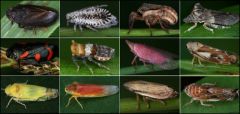
Leafhoppers |
Scientific name: N/A
Family: Cicadellidae. Suck plant sap from grass, shrubs, or trees. Commonly known as sharpshooters. Year-round in the south; spring through fall in the north, Some species overwinter as adults beneath leaf litter or matted grasses. Nymphs and adults feed on sap of above-ground stems or leaves of plants, Some species are most host-specific than others. |
|
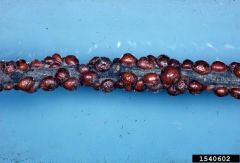
Lecanium Scale |
Scientific name: Eulecanium/Parthenolecanium spp. Host: Various Group of soft scales that infest a wide range of tree species. Attach to leaves and twigs and feed on plant nutrients. They excrete honeydew. Scales overwinter on twigs and branches. Crawlers emerge in late spring through early summer and migrate to the undersides of leaves where they feed until later summer. Move back to twigs to overwinter. One generation per year. Can cause twig dieback, stunt plant develop, and premature leaf drop. Insecticides: Xytect and Transtect. |
|

Lichens |
A fungus & algae association - not parasitic A lichen, or lichenized fungus, is actually two organisms functioning as a single, stable unit. Fungus living in a symbiotic relationship with an alga. Dominant partner is the fungus. Fungi do not contain chlorophyll and rely on other organisms for nutrition. |
|
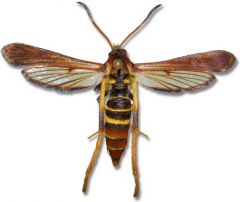
Lilac/ash borer |
Scientific name: Podosesia syringae Common wood borer. Damage caused by larvae which tunnel into the trucks and lower branches of ash trees into the heartwood. Irregularly round exit holes of about 1/4 inch diameter on trunks. When adult emerge the pupal skin often remains extruded from the hole. Trees may be killed by this insect, although that is rare. Larvae are creamy white grubs with a small dark head. Adults emerge early April to early May. Adults short lived. One generation per year. Insecticides apply mid-April and mid-May. |
|
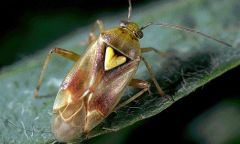
Lygus bugs |
Scientific name: Lygus sp. Bugs attack field & vegetable crops & tree fruits. Eggs creamy white inserted into plant tissue w/ only the cap exposed. Nymph pale yellow or green. Resemble adult but is smaller & has no wings. Adults vary from pale green to dark brown; yellow, black & sometimes reddish markings. Has a yellow triangular region called scutellum. Male darker than female. 3 generations/yr & sometimes 4th in the NW. Adults become active in spring. Nymphs feed by piercing tissue & extracting juices. Most damage done before/after bloom. Most damage occurs feed on flower parts or young fruit. Fruits deformed with deep pits. |
|
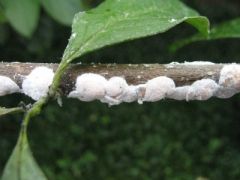
Magnolia scale |
Scientific name: Neolecanium cornuparvum Host: Magnolia Largest scale found in the U.S. Good at disguising itself. large size thou up to 0.5 inches makes it more conspicuous. Adult male scales are small, active and superficially resemble tiny flies. Adult female soft scales are large lens-shaped and may be covered with wax. Sucking mouth-parts used to remove large quantities of sap from twigs & young branches. Produces honeydew. |
|

Maple Petiole Borer |
Scientific name: Caulocampus acericaulis Host: Maple Maples suddenly drop green leaves during late May/early June. Is a non-stinging wasp commonly called a sawfly. Overwinter as pupae in the soil & emerge as adults in spring. 1/4" long w/ a dark colored head & thorax & a light colored abdomen. Lay eggs in the petioles (stems) of maple leaves in the spring. Larvae hatch, they tunnel into leaf petioles. Cream-colored with brown heads, legless, & 1/3" fully grown. 1 gen./yr. Defoliation of leaves. End of leaf petioles are often black and the leaves are usually still green. will not impact tree health. Drought, aphid, scale infestation generally happens in the summer & leaves typ. discolored. |
|
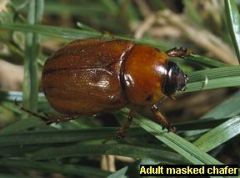
Masked chafer |
Scientific name: N/A Host; turfgrass Golden brown beetles 3/4" long w/ dark brown heads. Hairy on the underside of its thorax. Larvae white, c-shaped grubs with dark stripes on their backs and brown head capsules and legs. Grubs full grown about 1" long. Feed on roots of turfgrass. Damage appears in late summer or fall as irregular patches of brown, dying grass. Dig around roots in late fall through spring & look for whitish to yellow, wrinkled, C-shaped grubs. Look for yellowish-brown adults in early to mid summer. Aerating lawn can kill significant populations. Insecticides: imidacloprid. |
|
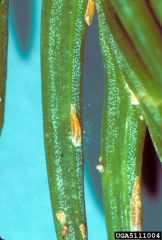
Maskell Scale |
Scientific name: Lepidosaphes pallida Family: Diaspididae Host: Cryptomeria (devastating to junipers) Scales are extremely small. The scalehas an armored, elongated oyster shape about 1.5 mm long. They tend to be golden, light brownto brown in color.It takes a while for the crawler stage to become an adult and start inducingshoot damage; so damage on the trees tends to appear first in the lower portions of the stems. Yellowing and browning of foliage, Dieback of branches. |
|
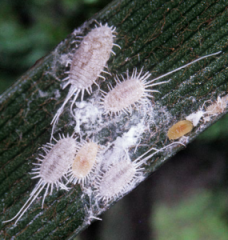
Mealybugs |
Family: Pseudococcidae. Unarmored scale insects found n moist, warm climates. Pests that feed on plant juices of greenhouse plants. Get common name from white waxy secretions that cover their bodies. Overwinters as nymphs & eggs. Mealybugs infest all plant parts; feeder roots, root crowns, stems, twigs, leaves (mostly undersides), stems, branches, & joints. Pierce & suck sap, excreting as sticky honeydew over leaves/stems providing growing medium for a sooty-colored mold. Heavily infested plants will experience irregular or no growth, yellowed leaves, & significant leaf drop. Left untreated, plants can die. 2 gen/yr is common. 8 gen possible in greenhouse. |
|
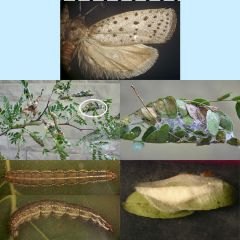
Mimosa webworm |
Scientific name: Homadaula anisocentra Host: Mimosa, Thornless Honeylocust Larvae 16mm long, grayish to dark brown & have 5 white stripes running the length of the body. Head is brown & body is slender. If disturbed will wriggle & lower themselves on silk strands. Adults are steel-gray moths with small black dots on their forewings. 13mm wingspan. Eggs are small, oval, and white that turn a rose color just before hatching. 2 generations a year. Adult appear in early mid-june. larvae hatch mid to late June. Larval most damaging. spin web around leaflets and continue to feed within protected area. |
|
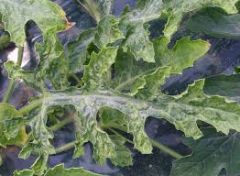
Mosaic/Mottle |
Scientific name: Various viruses Host: Rose, Camellia, Dogwood, Aspen Many viruses. Doubt it will be on test. |
|
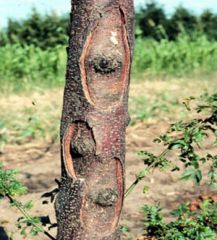
Nectria canker |
Scientific name: Nectria sp. The fungus Nectria invades wood damaged by freezing, hail, animals, and insects. Most hardwoods with such injuries are susceptible to attack. Slightly sunken Cankers develop around wound or damaged tissue. Smooth barked areas are generally darker brown than surrounding bark. If bark of tree is rough and dark, the canker is very difficult to see. Fungus is an opportunistic pathogen readily attacking damaged wood. Active all times of year when temps are above freezing. Can girdle and kill the branch or small trees. |
|
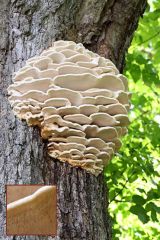
Northern Tooth Fungus |
Scientific name: Climacodon septentrionalis Host: Maple Unusual combination of both a shelf (also called bracket) fungus as well as a toothed fungus. Parasite of living trees, especially Sugar Maples, and it causes the central heartwood of the living tree to rot. The only sign that maple has this fungal parasite is the appearance of these shelf-like fruiting bodies in late summer or fall. Often trees with this fungus become weak and are blown over by the wind. As with most shelf fungi, it is considered to be inedible. |
|

Cypress tip miners |
Scientific name: Argyresthia sp. Host: Cypress, Juniper, Arborvitae, redwood Family: Cupressaceae. The adult is a small gray, narrow-bodied moth which lays its eggs on the tips of new growth in the spring. The eggs hatch and burrow into and mine the branch tips. They remain there, feeding, through winter until early spring. Emerge and spin a silken cocoon in mid-April. One generation per year. Larval feed cause tips to turn brown in the late winter and spring and later defoliate. Will not kill the plant. |
|
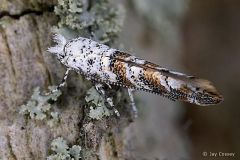
Oak Leaf Miner |
Scientific name: Cameraria hamadryadella Host: Oak Moth of the Gracillariidae family. Wingspan is 6.5-8.5mm. 2 generations per year. Larvae feed on Quercus species. They mine the leaves of their host plant. The mine consists of an upperside blotch. They overwinter in leaf litter as diapausing larvae within the leaf mine. |

